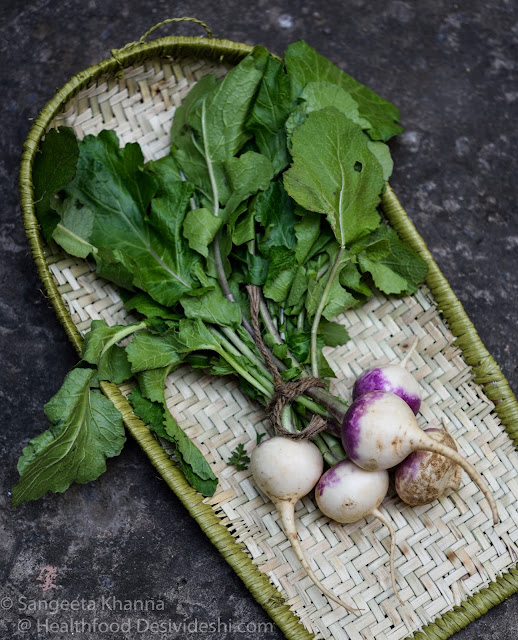Shaljam patta gosht was served at my Banaras ka Khana festival last year at ITC Maurya. Since this time we showcased the Ganga Jamuni tehzeeb of Banaras and teamed up with Rana Safvi to bring some food from Muslim homes as well, this homely recipe of shaljam patta gosht was included as I always prefer serving seasonal foods from the region in my food festivals.
Shaljam patta gosht is made almost similarly in many Muslim homes, Some people like to add a hot ghee tadka with ginger julienne and red chillies or green chilies over each serving and some have it as it is after the slow cooking. Use of garam masala is rare for this everyday recipe but some add whole spices too. Some people have started cooking it in one step pressure cooker process but I feel the slow cooking suits this delicate recipe better. My recipe is based on my trials after talking to a few Muslim friends from Banaras and other places close by.
Shaljam or shalgam is the humble turnip that many people hate for reasons beyond my understanding. I find it a very flavourful vegetable that has a delicate flavour and pairs well with many other ingredients really well. So while shalgam matar ki subzi remains my favourite and the Kashmiri style gogji nadur keeps repeating in my kitchen, bhien shalgam matar ki subzi is loved as much but I am yet to perfect my shalgam gosht.
The shaljam patta gosht is an everyday meat curry that uses leaves of turnips. It will be appropriate to mention that turnip leaves are many times more nutritious than the more common spinach and has one of the highest amounts of iron and calcium. Normally I would get it from Tijara farm as getting turnips with leaves is next to impossible in Delhi.
The other day Atiya Zaidi tweeted about shaljam patta gosht and I couldn't resist but look for turnip leaves in our weekly market. While I couldn't find any turnip leaves as usual, my quest was so intense that I saw a sack of medium sized fresh turnips being opened and the sack was sealed using the leaves from the same turnips as a cushioning material. I requested the subziwala to give me those leaves and he relented after initial hesitation. There I was, the leaves were very fresh to be cooked with my shaljam patta gosht.
ingredients
(3-4 servings)
500 gm mutton on bone and some fat
1/2 cup finely chopped onions
2 tbsp mustard oil
300 gm turnip leaves chopped finely*
5 whole dry red chilies
3 tejpatta
salt to taste
*The turnip leaves should ideally be from baby turnips but I have always used the leaves from medium sized turnips as I never find baby turnips, thankfully the shaljam patta gosht has always turned out great. If using baby turnips you can use the turnips chopped along the leaves too.
ingredients to make a fine paste together
1 tbsp minced garlic
1 tbsp minced ginger
1/4 cup chopped onion
1 tbsp coriander powder
1 tbsp cumin powder
1 tsp pepper powder
1 tsp turmeric powder
1/4 tsp red chili powder
procedure
Heat the mustard oil in a pressure cooker pan and add 1/2 cup chopped onions along with the whole dry red chilies and tejpatta. Fry them on medium heat till they get brown. Make a paste of the ingredients listed under paste while the onions brown.
Once the onions are browned, add the paste and get ready for some slow bhunoing for 20 minutes. keep the flame low and keep bhunoing the masala till it gets dry and sticks to the bottom leaving the oil on the sides.
Splash 1 tbsp water in the masala and bhuno again to deglaze, so it slows down the bhunoing process and brings out the complex flavours of the simple spices used.
Bhunoing is the key to the taste of many such mutton curries as our elders have stressed upon.
When you see the masala getting a deep shade of brown and aromatic, add the mutton pieces and keep bhunoing for 20 minutes more on low flame. Keep turning the meat along with the spices so the fats are rendered into the masala slowly and the meat absorbs the spices well.
Add the turnip leaves, mix the leaves well with the meat and let them release their juices. Once the leaves are wilted you can bhuno the meat mix for 5-7 minutes more. I often get the leaves steamed to make them limp so that I can refrigerate the in my borosil boxes, so I use steamed leaves from the fridge.
Add 1/4 cup of water (no more please), salt to taste and cover the lid. Keep the gas flame low and let the meat cook on very low flame till pressure builds up on its own, it takes about 40 minutes in a 2.5 liter pressure cooker. Once the whistle blows up you can switch off the gas and let the pressure release before opening the cooker.
Note that the cooking time can vary depending on the quality of meat, the flame strength and the size of pressure cooker so adjust accordingly. New cooks often err on this aspect and end up with under cooked or overcooked meat but that's how we learn.
You would see loads of leaves covering all the meat but trust me that is where the taste is. This cooking process ensures that the fats and gelatin from the bones melds well with the leaves and the turnip leaves flavour the meat with their own signature aromas.
Shaljam patta gosht tastes even better the next day so make double the amount you need for one meal. This is one mutton curry that can be eaten 3-4 times a week and is worth cooking in bulk and stock in the fridge.
















